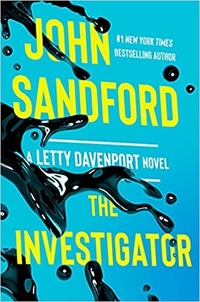The Investigator by John Sandford
 Monday, April 11, 2022 at 7:35AM
Monday, April 11, 2022 at 7:35AM 
Published by G.P. Putnam's Sons on April 12, 2022
John Sandford has never been a friend to readers on the far right. Some readers made that clear in Amazon “reviews” of Lucas Davenport novels in which Davenport prevented the assassination of a female Democrat who was running for the presidency and tackled threats from white supremacists. The “reviews” portrayed Sandford as a propogandist for the far left despite his love of guns, the value he places on law enforcement, and his apolitical approach to p4otagonists. Readers who value thrillers that paint everyone from the Middle East as evil incarnate while pretending domestic threats only come from “antifa” will probably want to stay away from Sandford, notwithstanding (or because of) the political centrism he brings to his novels.
The Investigator is the first novel to star Letty Davenport. Letty is Lucas’ adopted daughter. She has many of Lucas’ traits. She loves guns and isn’t bothered when she kills people, although she doesn’t kill them indiscriminately. She’s not much interested in most people who don’t work for law enforcement. She’s really not fond of violent extremists.
Letty is working in an internship for a senator who assigns her to work as a Senate investigator attached to Homeland Security because of her unique skills, including her willingness to conduct searches for which the police would need a warrant. She works with a former Delta, now a Homeland Security agent, to track down a threat posed by multiple militias in Texas. The militia leader, Jane Jael Hawkes, has a problem with migrants. Hawkes' own militia sometimes kills “illegals” rather than helping the Border Patrol take them into custody. Now she’s purchased stolen C4 and has teamed up with other militias to do something nefarious. It is clear to the reader that the nefarious act will have something about a caravan that is moving through Mexico on its way to a town in Texas that might offer refugee status to the travelers. Hawkes and her followers brand any political leader who would allow refugees into the country as "traitors."
The Investigator is chilling because the story’s foundation is convincing. You only need to dive into the comment sections of any mainstream news site/blog to understand how many people in this country prefer lies to facts, bigotry to tolerance, and guns to reason. They blame everyone but themselves for their circumstances. While their complaints about “elites” or “rich people” might be founded in the real world, they expand their grievances to include powerless individuals, including migrants, who cause them no harm. The powerless are easier to threaten or beat or kill than the powerful corporate leaders who ship jobs overseas while convincing workers that unions will somehow make their miserable jobs worse. People harboring irrational grievances who believe problems can be solved with guns are easily manipulated. The Investigator illustrates how easily manipulation might lead to tragedy.
Sandford’s fans know that Lucas Davenport novels can be dark while Virgil Flowers novels tend to be a bit lighter. The Investigator is on the darker side. Sandford’s dialog is always characterized by characters taking friendly shots at each other. Letty and her DHS partner do the same as they bond, but that dialog offers the only humor in a novel that takes the threat of domestic terrorism seriously.
Letty’s initial investigation give the novel the feel of detective fiction. The story gradually transitions to an action novel as Letty and her Homeland Security sidekick, without any of the superhuman antics of tough guy thriller heroes, take on the militias that have invaded a Texas town. The combination of investigation and action has served Sandford well. It is particularly effective in The Investigator. High-octane action and smart plot combine to make The Investigator one of my favorite Sandford novels. Sandford can probably make any character carry a series, but Letty clearly has what it takes to star in future novels.
RECOMMENDED



